The property report we’ve been waiting for
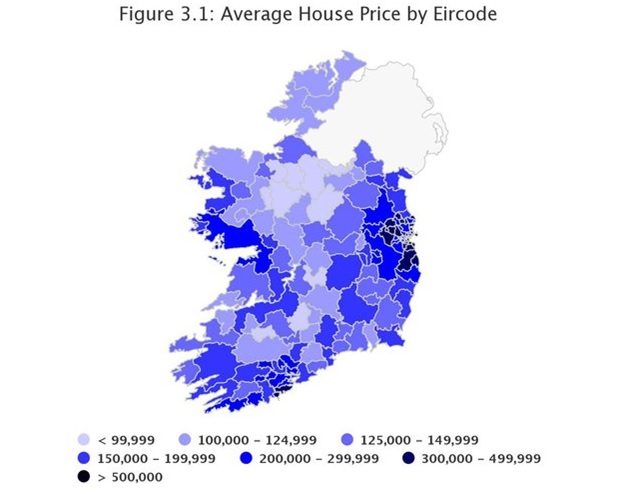
Every few months, the team here at Kinsella Estates bring you the round up of property statistics and trends from the previous quarter but this week we have even bigger news. The Central Statistics Office , or CSO, have released a special housing report, based on the latest census figures. This is a big deal as it offers an insight into the market and key measurements that we only get once every five years and for those who have been watching the market over the last five years, you will know that there have been lots of changes – good and bad. This is the first such report since the market started to recover in 2012 and it definitely going to cause a bit of trouble as it contradicts new housing supply numbers released earlier this year by the Department of Housing.
The report covers total housing stock levels, new builds completed and the changing patterns of renting, for example, the trend towards older people renting rather than owning their own home. One Irish Times journalist described it as “a picture of everything we wanted to know about the Irish housing crisis but were too afraid to ask”.
Looking at the 12 months up to March this year, we can see that the overall residential market is up almost 11%. Broken down, this translates into increases in the capital of just over 8% while areas – particularly in the west of the country, which was well behind the recovery we have seen here in the south east – have seen house price growth of up to 20% in the last year. In general, the property market in Ireland is still about 30% below peak levels last seen in 2007.
In terms of volume, the total number of homes purchased over the last year (February 2016 to February 2017) is 37,294. What is interesting to note is the breakdown by buyer type; only a quarter of all buyers were first-time buyers and less than a quarter were investors or non owner-occupiers. This means that homebuyers trading up and down, and those buying holiday homes, represent the driving force within the market. People might be surprised to learn that the average home price in Dublin is now €398,319 and it is difficult to believe that that could have been achieved without the relaxing of the Central Bank lending rules last year and the introduction of the controversial Help-to-Buy scheme. The average price paid for a home nationwide is currently €245,165. In County Wicklow, house prices are the highest outside of Dublin, with an average sale price achieved of €313,023. Take a look at the image above (figure 3.1) for an indication of where real progress has been felt and where the recovery has effectively bypassed.
Outlook
While it is not good news for house-hunters, property prices are set to increase by double digits again this year. In fact, Davy Stockbrokers said that 10% is a conservative estimate of future growth this year and the real figure might be much higher. This will come as a great relief to sellers and homeowners currently caught in the negative equity trap but it raises the ugly question: Is double digit growth sustainable without significant development and can buyers truly depend on new supply coming into the market? Unfortunately, there is no single answer to this but as the new homes specialists in counties Wicklow and Wexford, Kinsella Estates are in a good position to help would-be buyers identify new developments coming up locally over the next 18-24 months.
For specific queries or to speak with a local property expert about your buying and selling needs in Wexford, Wicklow and surrounding areas, contact Michael, Alan or Eileen Kinsella at kinsellaestates.ie . Alternatively, you can email me directly on michael@kinsellaestates.ie or telephone : +353 53 94 21718 to arrange a viewing on our qualifying new builds.
What house-hunters are REALLY looking at when viewing your home
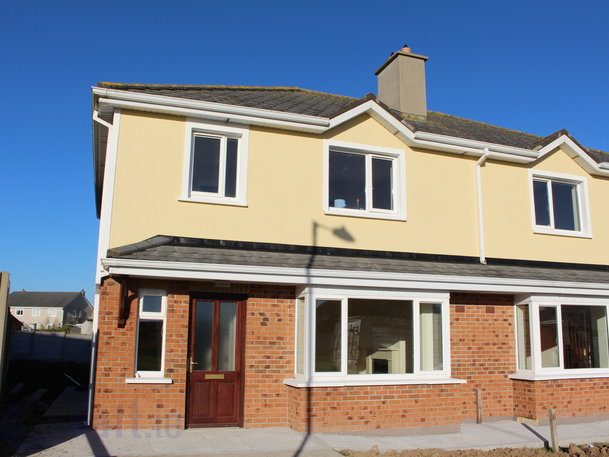
Forget the smell of home baking or fresh coffee brewing, a recent survey of house-hunters reveal that a surprisingly high figure of 95% will walk straight to the property’s windows to find out what the view is like.
This research is the first of its kind as it equipped house-hunters with eye-tracking goggles that recorded where people viewed, how often they returned to the same spot and how long they spent in any part of the room.
Now that I think about it, it makes complete sense. Buyers will know what the exterior of the home looks like from the online posting and from arriving outside, as an estate agent, I know first-hand the importance of ‘kerb appeal’. And I can gauge the first impressions of prospective buyers the second they enter the house; some are more discreet (or polite!) than others but it doesn’t take long to figure out whether this is the home for them.
Once inside the front door, and this is true for most rooms they enter, viewers will instinctively head straight for the windows to check out the aspect of the room and, depending upon what they see, a certain impression is created. This is why rural homes are best seen in daylight and preferably sunshine – luckily for us, we operate out of the sunny South East so our homes have the edge.
So, knowing the importance of views to would-be buyers, it definitely makes sense to clean up the gardens, dispose of any rubbish or scrap metal and – depending upon the season – have a few planters positioned within the sight of the main windows. Of course, as we approach daffodil season, this task becomes much easier.
Sellers, I have posted before on the importance of giving your home a thorough cleaning and decluttering before bringing your home to the market, so let’s add touching up the garden to the ‘to do’ list. Also, knowing that intending buyers walk straight to the windows, please do ensure that window are sparkling clean, window stills are freshly dusted and decades-worth of ornaments are packed away, ready for moving to their new home. I understand that it is difficult for proud homeowners to accept this but house-hunters need as blank a canvas as possible so that they can imagine their own possessions and family pictures in each room.
Also, while we always stay with the house-hunter to ensure the security and privacy of our sellers, most will look into larger storage presses and under the stairs so avoid the temptation to pile stuff in there when tidying.
Other surprising facts that this research showed up include how viewers barely glance at floors and surfaces but tend to pay more attention to ceiling and cornicing so be sure to keep an eye out for any draping cobwebs.
Finally, a bit of good news for sellers who are scrubbing their property, getting ready to present it to the market, apparent none of the house-hunters opened the oven to check how clean it was!
For specific queries or to speak with a local property expert about your buying and selling needs in Wexford, Wicklow and surrounding areas, contact Michael, Alan or Eileen Kinsella at kinsellaestates.ie . Alternatively, you can email me directly on michael@kinsellaestates.ie or telephone : +353 53 94 21718 to arrange a viewing on our qualifying new builds.
Dublin is ‘Eating’ Ireland: Wicklow & Weford Set to Benefit
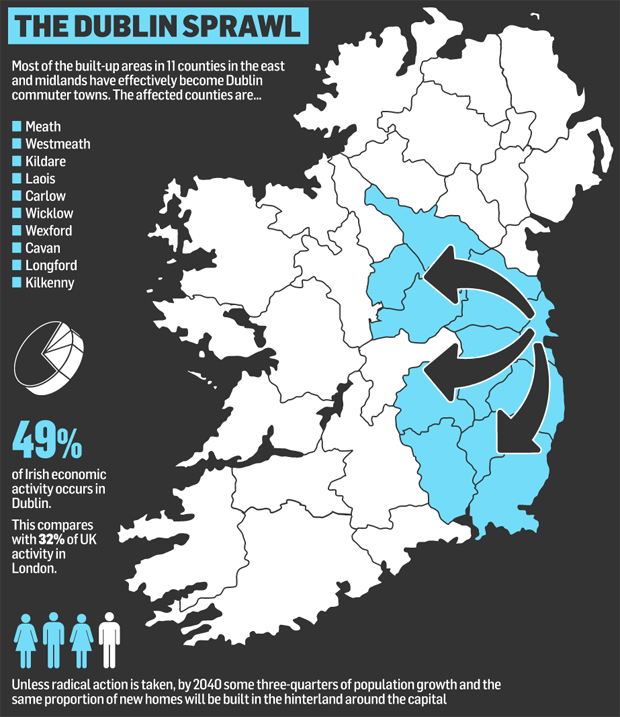
According to the Independent newspaper reporting of the recently released ‘Ireland 2040’ document, Dublin is “eating” the rest of the country
The report, launched by an Taoiseach and the Housing Minister last week, makes for tough reading for most of rural Ireland. It charts the gradual decline of rural businesses, communities, towns and villages. The simple reality is that when money leave an area, the people must surely follow. And this is exactly what happened. Today, close to half of all economic activity (49%) is generated in Dublin, which is pulling the labour force away from their home counties and closer to the capital. That figure is particularly worrying when you compare it to our closest neighbours; London generates only 32% of England’s economic activity.
We have been hearing about a two-tier country since the early days of the property crash and here in the South East, we know first-hand that recovery is not happening in a fair, uniform way. But this report forecasts where the population will be by 2040 if these trends continue, and it’s not good news for the majority of the country.
As we can see from the above image, all parts of counties Wicklow and Wexford are likely to benefit from this over the coming years and decades as the commuter-belt widens.
Over the past 20 years, half of the population growth in the entire State has been in and around the Dublin area. Without some big changes, this number is set to jump to 75% of population growth happening in that region by 2040. This is dire news for many but the South East is now looking more and more attractive, and not just for home buyers and investors. Businesses looking for a base outside of the capital, healthcare providers, education centres and other service providers are likely to come in this direction.
The work, development and investment cluster will not necessarily happen in Dublin. In fact, the report suggests that Dublin is or will become ‘the Dublin City Region’, extending into 10 other counties from Cavan to Wexford.
This report will impact hugely on our local planning over the next few years. As more commuters look south of Dublin and Wicklow, into Wexford, we must ensure that we have enough homes, hospital beds, school places and other necessary facilities for our growing population. For investors looking to buy strategically, Wexford offers particular value for money with ever-increasing potential for capital value appreciation.
Finally, there is a new State plan to save our rural towns and villages underway, this plan includes grants and incentives for buyers to restore derelict homes, and we’ll talk more about this next week.
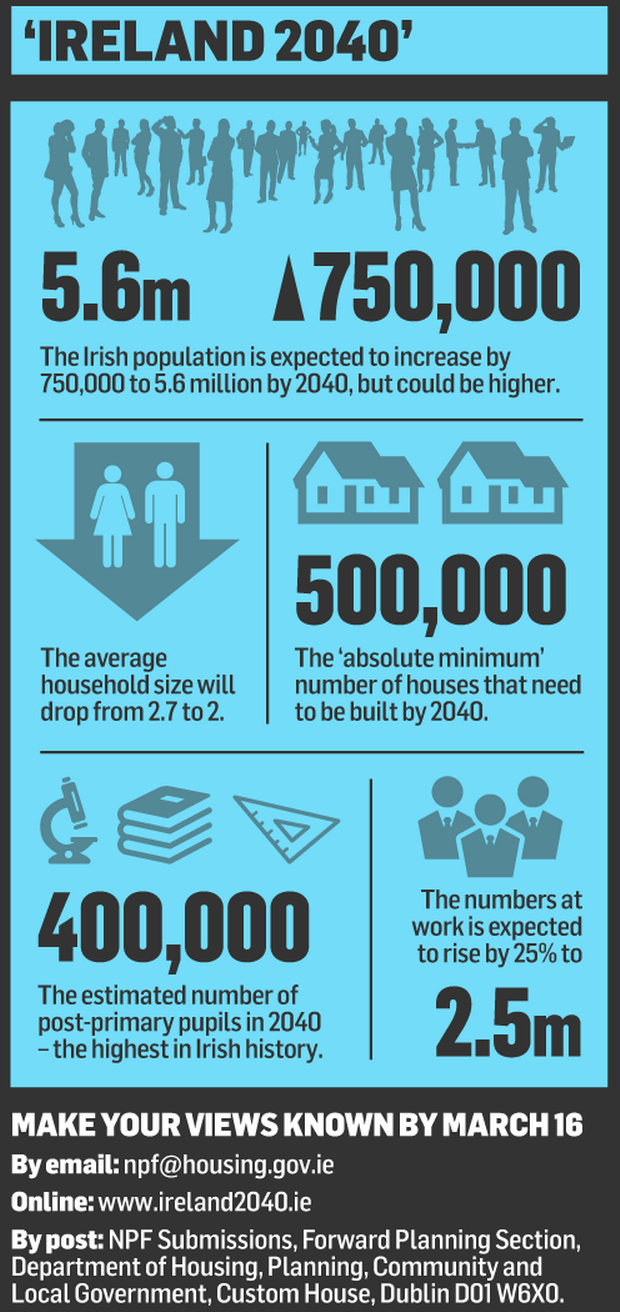
For specific queries or to speak with a local property expert about your buying and selling needs in Wexford, Wicklow and surrounding areas, contact Michael, Alan or Eileen Kinsella at kinsellaestates.ie . Alternatively, you can email me directly on michael@kinsellaestates.ie or telephone : +353 53 94 21718 to arrange a viewing on our qualifying new builds.
Your Guide to the Help-to-Buy Scheme
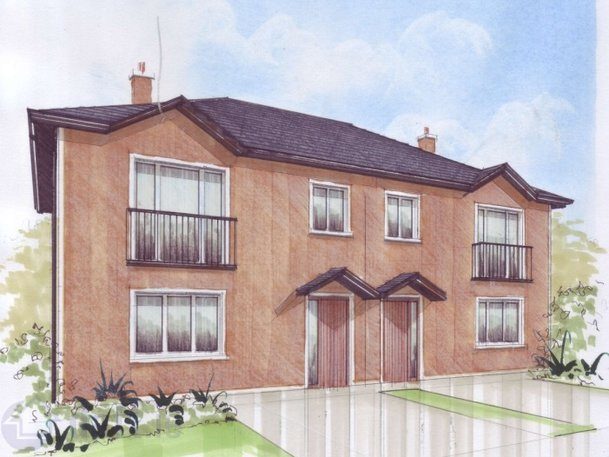
Budget 2017 announced the Help-to-Buy scheme, which has proven controversial within the industry, to help intending first-time buyers to put together the deposit required to purchase or self-build their new house or apartment.
The scheme works by way of an income tax and DIRT tax refund, in respect of payments made over the previous four tax years. There are three types of applicants who can apply for the Help-to-Buy scheme, namely: retrospective applicants or buyers whose contracts are signed between 19 July 2016 and 31 December 2016; first-time buyers whose contracts are signed between 1 January 2017 and 31 December 2019; and first-time self-build applicants building between 1 January 2017 and 31 December 2019.
Eligibility:
- The buyer must be a first-time buyer, specifically, the buyer must not have either individually or jointly with any other person (directly or indirectly), previously purchased, or built a property. Where more than one individual is involved in purchasing or building a new home, all of the individuals must be first-time buyers.
- The house or apartment must be a new-build (may be self-built)
- The purchase must be dated between 19 July 2016 and 31 December 2019
- The property must have been purchased or built as the first-time buyer’s home and not acquired for investment purposes.
- The property must be occupied by the first-time buyer, or at least one of the first-time buyers in the case of multiple first-time buyers (a group), for a period of five years.
How to apply:
- Registered for myAccount (PAYE) or ROS (self-assessed)
- PAYE taxpayers will need to complete Forms 12 (available through ROS) for the tax years selected for refund
- Self-assessed taxpayer will need to complete Forms 11 (available through ROS) for each of the four years immediately prior to the claim. Please not that any outstanding taxes must be paid.
In order to apply for the scheme/refund, buyers must enter the following information online:
- Property details including address and price
- Details of each first-time buyer and refund agreed
- Developer/Contractor details or
- Details of the Solicitor if self-building
- Upload a copy of the signed
- Balance of the deposit to be paid
- Contract completion date
- Mortgage details
- For self-builders, proof of drawdown of the first mortgage tranche payment
All details must be verified by the Developer/Contractor in the case of a new build, or by the purchaser’s Solicitor in the case of a self-build, before the refund can be paid out.
For further details on the scheme, contact the Office of the Revenue Commissioners
For specific queries or to speak with a local property expert about your buying and selling needs in Wexford, Wicklow and surrounding areas, contact Michael, Alan or Eileen Kinsella at kinsellaestates.ie . Alternatively, you can email me directly on michael@kinsellaestates.ie or telephone : +353 53 94 21718 to arrange a viewing on our qualifying new builds.
EAST COAST FM: Thank You
Huge thanks to everyone who came along and supported our East Coast FM Coffee Morning to raise money for cancer services throughout County Wicklow. I am delighted to say that the team here at Kinsella Estates, together with our clients and friends raised €960 so far, with more money still coming in daily.
This is a great sum raised for a great cause – we were delighted to get involved this year and genuinely appreciate the support locally.
Thank you all,
Michael, Eileen and the team here at Kinsella Estates
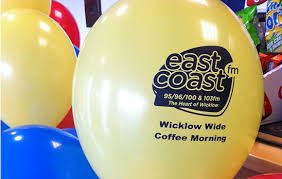
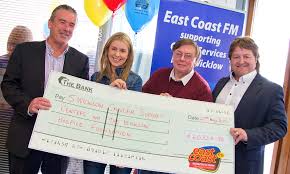
Auctions: It’s Not all About Land and Buildings
Most people, when they hear the word ‘auction’, they automatically think of land or property but licensed auctioneers are actually involved in selling a host of other stock – including livestock – for a range of private and commercial sellers.
Here at Kinsella Estates, we have been involved in the auction business for almost 50 years from our base in the South East. While we now have offices in Carnew, County Wicklow and Gorey, County Wexford, we acquired a yard in Carnew back in 2010 especially for our furniture, plant and machinery auctions. When we use the term ‘Plant’, we are referring mainly to heavy duty building or construction equipment, while ‘Machinery’ is generally made up of farm equipment.
During the recession and throughout this stage of recovery, we got repeated requests from businesses who needed to we sell off machinery, plant and trade tools in order to raise or recoup money. On the basis that Kinsella Estates had its origins as part of a livestock mart going back many decades, we have extensive experience holding auctions. Perhaps more importantly, our contacts and relationships within the local farming community mean that we can attract the right bidders on the day!
Typically where a group of farmers get together in an area and request us to sell machinery on their behalf, we would invite outside lots with the permission of the relevant parties. At previous auctions, we have offered a number of lots for sale on behalf of seller clients but other sellers also brought along their own lots that they wished to sell on the day.
Another example of the type of non-land auction activity we are involved in might be for farm contents (separate to selling the farm holding itself). Over the years we have sold many farms and the vendors or beneficiaries often request that we sell the farm contents.
A successful auction has, at its heart, the right bidders in attendance. This is where our experience and network of contacts add value. We target our advertising to reach the relevant audience. This involved a mix of newspaper advertising, signage, an email/text campaign and the all-important word of mouth. We attract a large volume of crowds from all around the country. We are proud to have significant repeat business from both buyers and sellers.
Our auction team consists of licensed auctioneers, clerks, office/accounts administration and yard men.
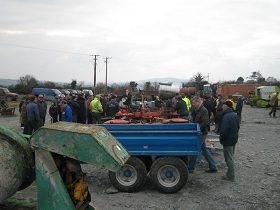
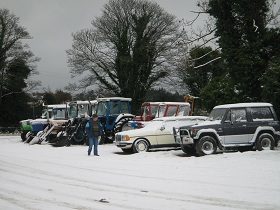

How it works on the day:
- Purchasers will have the option to view the equipment and machinery the day before the auction up and until such time as it goes under the hammer.
- The auction itself might start at 11am but there is no pre-determined end time. Any auctioneer worth his (or her) salt will stay selling as long as the goods are there to sell bidders remain! Certainly, there are peak auction times in the mid-afternoon but serious bidders will hang around.
- Once the equipment is sold the clerk sends his/her information to the office administrator. The purchaser can then go to the office to pay.
- The purchaser will receive a ‘passout’ (proof of purchase) which is given to the yard men to verify that the equipment has been paid for and can be removed from the yard.
- After sales: We will always have an aftersales team member available on site in case there is equipment which did not meet the reserve price, which we may sell after the auction.
We know the importance of attracting the right bidders so when we are planning a date for an auction we always ensure that there is no other auction on that same day within a 50 kilometer radius. While that might seem excessive, our experience tells us that potential buyers do travel from all over to attend same. Of course, we also take into consideration the peak calendar months for a typical farmer. For example in Spring lambing season and sowing season, the same follows through for harvest.
For specific queries or to speak with a local property expert about your buying and selling needs in Wexford, Wicklow and surrounding areas, contact Michael, Alan or Eileen Kinsella at kinsellaestates.ie.
Email me directly on michael@kinsellaestates.ie or telephone: +353 53 94 21718
